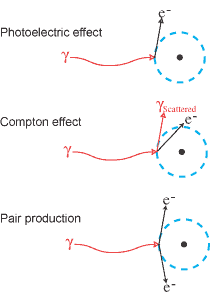Another kind of log that measures radioactivity is the gamma-gamma log. Such logs are based on the principle of interaction between an incident radiation and the atoms of a formation subjected to radioactive bombardment.
Formations are bombarded with a constant gamma radiation (energy in the range of 0.1 and 1 MeV) produced by a chemical source like 137Cs. These gamma photons collide with electrons of the material. For every collision, the energy of each photon is reduced. This energy attenuation can take three main paths: photoelectrical effect, Compton effect, pair production.

![]() Corpuscular interaction
Corpuscular interaction
Within the density limits and energy fields with which we are concerned, the Compton effect is clearly more predominant over other modes of attenuation.

![]() Predominant effect in the Z,E space.
Predominant effect in the Z,E space.
In this reaction, the incident photon loses only a part of is energy in ejecting an electron and continues its trajectory in another direction as a scattered photon.This effect is proportional to the number of electrons, Z, of the elements involved. The detector consists of a scintillation counter regulated in such a way that it counts only those gamma rays that are above a certain energy threshold.